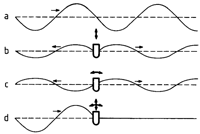What about Wave Energy?
August 1, 2009

Harnessing the power of surface waves. Pelamis, a device that has been deployed off the coast of Portugal by the Scottish company Pelamis Wave Power, consists of a chain of linked cylindrical segments that flex with the action of the waves; the flexing drives a hydraulic pump. From Pelamis Wave Power.
The other half of the renewable marine energy equation is wave power. Unlike tidal energy, which comes mostly from the moon's gravitational attraction, wave energy is basically solar energy twice removed: Heating from the sun creates wind, which agitates the surface of the ocean. Wave energy has the advantage of being available in more places than tidal, which at present seems to be economically feasible only in places with relatively strong tidal currents. The Electric Power Research Institute estimates that wave energy could supply about 6.5% of the national electricity market in the U.S., or about twice as much as tidal energy.
A couple years ago, when wave energy was the venture-capital fad du jour, the World Energy Council listed 32 companies with wave energy projects in the research or development phases. Now that a recession has hit, Margot Gerritsen says, "I don't know where the money will come from. I fear for these startups." However, she continues, "For us this is a good opportunity to take more time to think. For a while things were going fast, probably too fast, with venture capitalists putting money into ideas that were not well thought out."
By most accounts, the early leader in wave power is a Scottish company, Pelamis Wave Power, which has deployed a device called Pelamis (from the Greek word for "sea snake") off the coast of Portugal. Pelamis is a chain of slender floaters that flexes because of the action of the waves, like a mythical sea serpent slithering through the water; the bending drives a hydraulic pump. The three installed devices have been generating 2 megawatts of power at a cost of about 28 cents/kilowatt-hour---still a long way from being competitive with fossil fuels, but not too dissimilar from the capability of wind energy 20 years ago.
"The principle of generating energy from waves is that you need to have relative motion," says Ronald Yeung, a professor of ocean engineering at the University of California at Berkeley. "You can either have a flexible snake, like the Pelamis, or you can tie down part of your generator." In the case of a "point absorber," the design that Yeung is working on, the energy is generated from the motion of a floater relative to its stationary anchor point.

To absorb waves means to generate waves. Curve (a) represents an undisturbed incident wave. Curve (b) illustrates symmetric wave generation (on otherwise calm water) by means of a straight array of evenly spaced, small floating bodies oscillating in heave (up and down). Curve (c) illustrates antisymmetric wave generation. Curve (d), which represents the superposition of (a), (b), and (c), illustrates complete absorption of the incident wave energy. First published in "Wave Power Conversion by Point Absorbers," J. Falnes and K. Budal, Norwegian Maritime Research, Vol. 6, No. 4, 1978, pages 2�11, this illustration was later reproduced as Figure 6.1 in Ocean Waves and Oscillating Systems: Linear Interactions Including Wave-Energy Extraction, J. Falnes, Cambridge University Press, Cambridge, UK, 2002. http://folk.ntnu.no/falnes/web_arkiv/InstFysikk/phcontrl.pdf. From Johannes Falnes. Reprinted with permission.
The problem of designing a point absorber has some interesting mathematical subtleties. "In two dimensions, for a single mode of motion, if your point absorber is symmetric, you can prove that it can absorb at most 50% of the incident energy," Yeung says. "However, a properly designed asymmetric shape can absorb 100% percent. Students are fascinated by that fact." Alternatively, a designer can exploit two modes of motion, allowing the buoy not only to bob up and down but also to rock back and forth. The bobbing motion absorbs the symmetric part of the incoming wave, while the rocking absorbs the antisymmetric part. In three dimensions, the problem is more complicated, but Yeung says that a point absorber can capture as much as 80 to 90% of the wave energy within its "capture radius."
Another surprise is that the wave energy converters need not be passive. It is sometimes possible to capture more energy by actively creating a wave that opposes the incoming wave. "It's counterintuitive," says Ted Brekken, an electrical engineer at Oregon State University. "You can actually run the converter as a wave maker. In the idealized situation, there is a certain amount of force you want the converter to produce, as a function of position, velocity, and pressure. If you know the frequency spectrum of the incoming waves, you're in great shape. Otherwise, you need to develop sensors that can look ahead and see what the spectrum is."
The mathematics of a single point converter has been understood for years, but in practice an array of converters is needed to generate a significant amount of energy. This fact adds one more layer of mathematical richness to the problem. "They interact with each other, and this creates interesting opportunities to optimize their interaction," Brekken says. "It's similar to an antenna array---you have an optimal control problem in a stochastic environment."
Although it is still far too early to forecast a winner in the tidal power/wave power derby, one thing seems likely---underlying the winner will be some serious mathematical analysis.---DM

